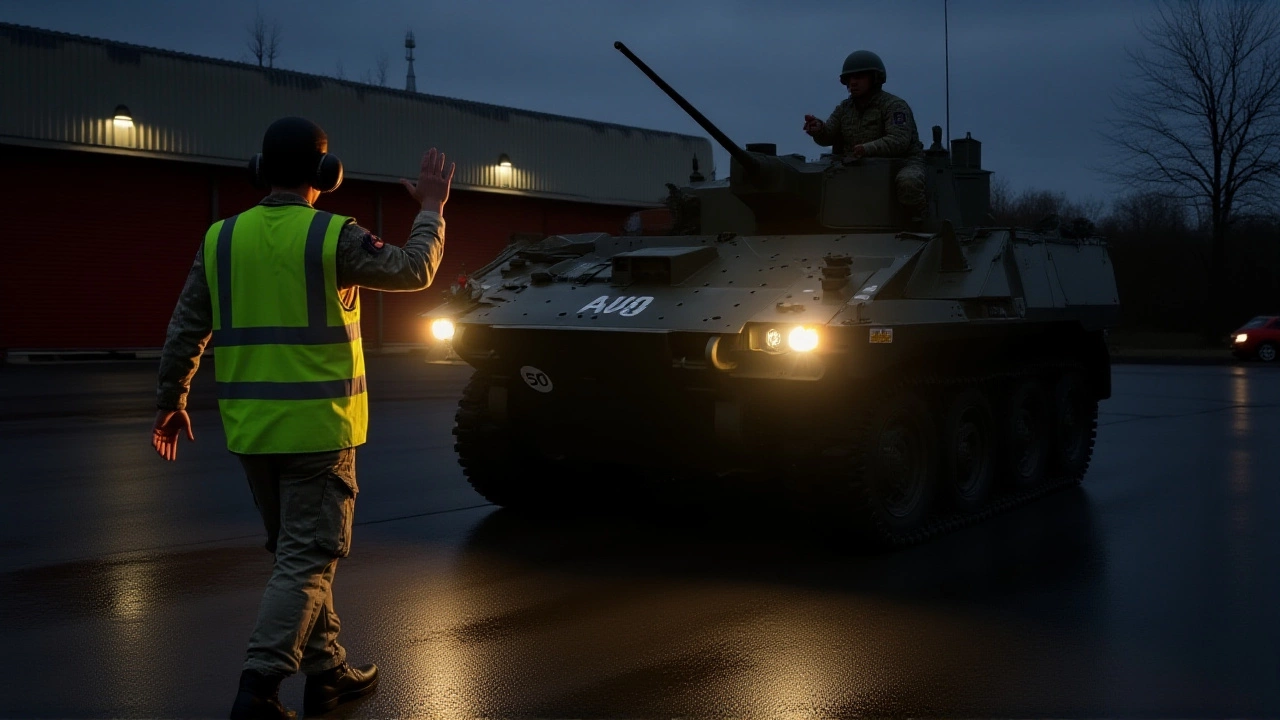The British Army has suspended all operations of its Ajax armoured fighting vehicles after 31 soldiers fell seriously ill during Exercise Iron FistSalisbury Plain, Wiltshire. The decision, announced at 17:30 GMT on Tuesday, November 25, 2025, came after troops emerged from 10- to 15-hour missions vomiting, trembling uncontrollably, and unable to stand without support. Defence Readiness & Industry Minister Luke Pollard issued an immediate Electronic Safety Notice banning all use of the £5.5bn vehicle platform — a move that effectively grounded the entire fleet for two weeks while a safety investigation unfolds.
What Happened on Salisbury Plain?
During the weekend war game, soldiers from multiple units spent extended periods inside the Ajax vehicles, which were designed for reconnaissance and rapid response. But instead of tactical advantage, many reported sudden, severe physical reactions. One soldier described it as "like being inside a washing machine on spin cycle for hours." Others said their teeth rattled, their vision blurred, and their hands shook so badly they couldn’t load magazines or hold radios. The symptoms — consistent with prolonged exposure to high-frequency noise and vibration — are not new. But this was the largest cluster ever recorded in a single exercise.The Army immediately halted the exercise and began testing all personnel involved. While a "vast majority" have since been cleared for duty, the Ministry of Defence confirmed that a "small number" remain under medical care. Three members of the Household Cavalry Regiment, a storied unit responsible for both ceremonial duties in London and frontline reconnaissance, are already facing medical discharge — a direct consequence of injuries sustained since the Ajax entered service.
A History of Warnings Ignored
This isn’t the first time the Ajax programme has made headlines for the wrong reasons. Since its inception in 2010, the project has been plagued by delays, cost overruns, and technical failures. Eight years behind schedule, the vehicle only achieved Initial Operating Capability (IOC) in early November 2025 — just days before the Salisbury Plain incident. Yet just two weeks prior, Minister Luke Pollard stood in Merthyr Tydfil, Wales, and declared: "Ajax has overcome significant challenges, but importantly, we can say it has left its troubles behind."That statement now rings hollow. Internal reports from the Defence Science and Technology Laboratory had flagged excessive vibration levels as early as 2018. Independent engineers warned that the vehicle’s suspension system, designed for speed over rough terrain, amplified frequencies that directly affect human neurology. The Army pressed ahead anyway, accepting 160 of the planned 589 vehicles — with more rolling off the production line even as complaints mounted.

Who’s Paying the Price?
The Household Cavalry Regiment has borne the brunt. These are elite soldiers — some of the most physically and mentally resilient in the British Army. Yet three have been medically discharged. Their injuries aren’t visible scars or broken bones. They’re neurological. Tinnitus. Chronic dizziness. Muscle spasms. One soldier, a 24-year-old troop commander, can no longer drive a car without nausea. Another, a veteran of Afghanistan, says he hasn’t slept through a night since returning from the exercise."We were told this was the future," one discharged soldier told BFBS Forces News anonymously. "Now I’m told I’ll never be fit for service again. And for what? A vehicle that shakes you apart?"
The Ministry of Defence insists that "medical discharges across the board are not attributed to individual vehicles." But that’s a technicality. When 31 soldiers fall ill during one exercise — and three others have already been forced out — the pattern is undeniable. The Ajax isn’t just malfunctioning. It’s harming people.
The Bigger Picture: A £6.3bn Question
The Ajax programme was meant to replace the CVR(T) vehicles, first introduced in 1971. It was supposed to be the backbone of Britain’s mechanized forces for decades. But with costs ballooning from £3.7bn to over £6.3bn in some estimates, and delivery timelines stretched beyond 2030, the project has become a symbol of defence procurement gone wrong.Even before the November incident, experts predicted full operational capability wouldn’t be reached for another four years. Now, with the entire fleet grounded, that timeline is in freefall. The Army’s ability to conduct large-scale exercises in 2026 — already limited by recruitment shortages — could be further crippled. And with NATO allies watching, Britain’s credibility as a reliable military partner hangs in the balance.

What Happens Next?
The two-week pause ends around December 9, 2025. But don’t expect a quick return to normal. The investigation, led by the Defence Safety Authority, will examine everything from the vehicle’s engine mounts to crew seating design. Independent acoustics experts from universities in Southampton and Cranfield have already offered to assist. Meanwhile, the families of affected soldiers are consulting legal teams. A class-action suit against General Dynamics, the programme’s primary contractor, is likely.Minister Luke Pollard faces mounting pressure. His November 5 assurance that the Ajax was "safe" now looks like either dangerous optimism or deliberate misrepresentation. Parliament is expected to summon him for an emergency hearing within days.
For now, the Ajax sits idle. The British Army has no backup platform ready to replace it. And the soldiers who were supposed to ride into battle — instead spent their weekend fighting for their own bodies.
Frequently Asked Questions
How do noise and vibration from the Ajax vehicle cause illness?
Prolonged exposure to high-frequency vibration — especially between 20 and 100 Hz — can disrupt the vestibular system, damage inner ear structures, and trigger neurological stress responses. Symptoms include vertigo, nausea, tremors, and tinnitus. Military studies from the 1990s already warned of these risks in tracked vehicles, but the Ajax’s design amplified these frequencies beyond safe thresholds.
Why didn’t the Ministry of Defence act sooner?
Despite repeated internal warnings dating back to 2018, the MoD prioritized delivery timelines and political messaging over soldier safety. Even after 120+ complaints from crews, officials dismissed them as "isolated incidents." The decision to declare Initial Operating Capability in November 2025 — despite unresolved issues — suggests institutional pressure to declare success, regardless of risk.
Who is responsible for the Ajax programme’s failures?
General Dynamics UK is the prime contractor, responsible for design and manufacturing. But the Ministry of Defence bears equal blame for oversight failures. Independent audits show MoD officials approved design changes without full safety testing, and ignored contractor warnings about vibration levels. Accountability remains unclear — but the soldiers are paying the cost.
What happens to the soldiers already discharged?
The three discharged members of the Household Cavalry Regiment are receiving lifelong medical support, but their pensions are likely to be reduced due to the classification of their injuries as "service-related but not combat-related." Advocacy groups are pushing for reclassification, arguing that training injuries should be treated with the same gravity as battlefield wounds. Legal action is pending.
Is the Ajax programme cancelled?
Not officially. The MoD insists the vehicle can be fixed. But with full operating capacity now delayed by at least six years — and public trust shattered — political pressure may force a rethink. Alternative platforms, including upgraded CVR(T) variants or foreign designs like the German Puma, are being quietly evaluated as contingency options.
How does this affect Britain’s military readiness?
The Ajax was meant to equip four reconnaissance regiments. With all 160 delivered vehicles grounded, those units are now effectively unarmed for armored operations. Training exercises are canceled, NATO interoperability drills are delayed, and recruitment into armored corps has dropped 22% since the November incident. Britain’s ability to project mechanized force in Europe is now in serious doubt.

